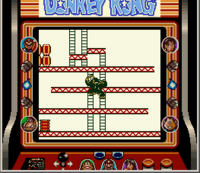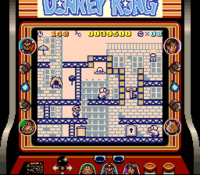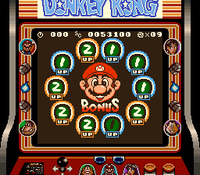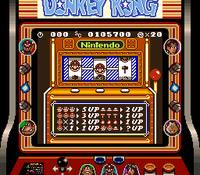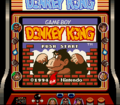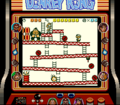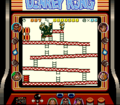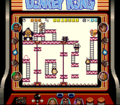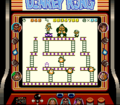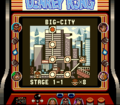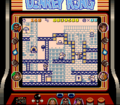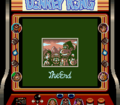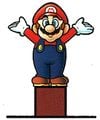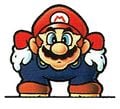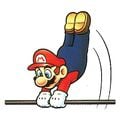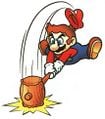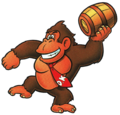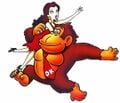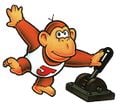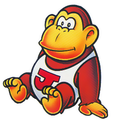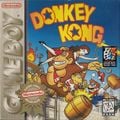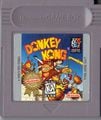Donkey Kong (Game Boy)
Template:Infobox Donkey Kong (alternatively Game Boy Donkey Kong, and Donkey Kong '94 in early development) is a Game Boy game released in 1994. The game begins with the premise of a straight remake of the original Donkey Kong arcade game, as the game initially comprises the four classic stages. However, Donkey Kong has another 97 stages beyond the first world, making it more than an enhanced remake of the original game. Donkey Kong also was the first game in the Mario franchise to support colored graphics when played on the Super Game Boy peripheral of the Super Nintendo, making it the first title in the extended Mario franchise to have Super Game Boy compatibility, followed by the Donkey Kong Land series, as well as Wario Land II. The Super Game Boy also provides a cartoon border designed to resemble the original Donkey Kong arcade cabinet. This game also features slight enhancements to the audio when played on the Super Game Boy: Pauline's distress cry is made to sound like an actual cry for help (the Super NES's sound chip supports the inclusion of voice samples), and the credits theme is enhanced as well.
Story
The player takes the role of Mario. The large ape Donkey Kong kidnaps Mario's lady friend Pauline and carries her off to a construction site. In a repeat of the 1981 arcade classic, Mario follows him up to the highest point and makes Donkey Kong fall off the platforms by pulling out the rivets supporting them, causing Donkey Kong to fall a height of 100m, reuniting Mario and Pauline, just like the events that took place 13 years ago. However, Donkey Kong unexpectedly recovers, takes Pauline, and escapes with her into the Big-City. Mario pursues the two.
What follows is a chase throughout many different locations. Mario fights and defeats Donkey Kong at the end of each world, but Donkey Kong always stands up again and takes Pauline to the next location. Donkey Kong is aided by many of his friends as well as his son Donkey Kong Jr., who try to hinder Mario's progress. In the end, Donkey Kong escapes to the Tower beyond Rocky-Valley, where he and Mario have a confrontation on the top. After his defeat, Donkey Kong falls off the tower, but he then takes many Super Mushrooms to augment his size to giant proportions. Mario faces the Giant Donkey Kong in an epic final battle. After the ape's final defeat, Donkey Kong falls from the tower once again as Mario and Pauline are reunited. The ending scene shows Mario and Pauline in the Mushroom Kingdom as Pauline gives him a Super Mushroom to turn Mario into Super Mario. As Mario becomes super, Donkey Kong (now being back to normal) falls down on top of him. But because Mario now has super strength, he is able to lift up Donkey Kong. Having believed to be captured by both Mario and Pauline, Donkey Kong calls out for help. Donkey Kong Junior comes to the rescue, possibly setting the stage for the sequel of Donkey Kong Jr.'s own game as the credits roll. The ending photo of the game during the credits shows Mario, Pauline, Donkey Kong, and Donkey Kong Jr. posing in front of Rocky-Valley for a holiday photo, indicating that they've all made amends with each other.
Stages
| Image | Information | Levels |
|---|---|---|
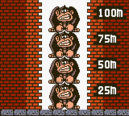
|
Construction Site - The construction site is the setting of the original Donkey Kong arcade game. In this world, Mario's goal is to get to Donkey Kong, who is standing on the top of the stages 25m, 50m, and 75m. Blocking Mario's path are enemies such as Fire, and platforms with gaps to jump across, elevators and Conveyor Belts. Donkey Kong will also throw Springs at Mario. In the final stage of the world, 100m, Mario has to pull out all the rivets of Donkey Kong's construction to defeat him. | 4 |
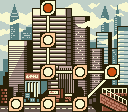
|
Big-City - Big-City is the first world of the game in which Mario has to unlock doors with keys. It is a basic world that serves as an introduction to the basic items and moves of the game, such as handstands, Roads, and Ladders. It also contains two boss fights with Donkey Kong. | 8 |
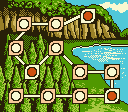
|
Forest - The Forest adds more gameplay elements to the game, such as ropes to climb and water to swim in. Switches also make their first appearance - they can make Roads appear and disappear. Snapjaws that climb on ropes can be taken out with fruit. These stages are a reference Donkey Kong Jr. | 12 |
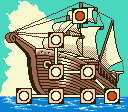
|
Ship - The stages on the Ship expand on the previously introduced game objects and add new puzzles to them. Mario now has to use Triple Jumps, Rope Spins, and Chunks (to get over spiked gaps) to progress. | 8 |
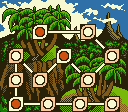
|
Jungle - The Jungle expands on all types of levels found in the Forest. The complexity of ropes increases, and there are ally creatures like the Monchee and frogs that help Mario to reach more areas. Enemies such as Dorakyū hinder Mario's progress while climbing ropes. | 12 |

|
Desert - The Desert is the first world to feature Super Hammers. They are used to break through walls. Most desert levels have more complex puzzle elements than previous stages. In one stage, Mario has to take the Key up several stories to the Door by only using Ladders, Roads and Springs. | 12 |
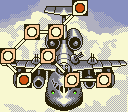
|
Airplane - The Airplane is the only world in the game not to feature generic enemies. Airplane levels often feature winds that blow Mario away sideways. He has to work across elevators, conveyor belts and has to avoid many cannons. The amount of moving platforms increases. Airplane stages also feature more than one locked door - the player has to remember the right one from which Pauline is seen screaming in the stage's intro. | 8 |
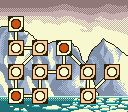
|
Iceberg - The Iceberg features many slippery surfaces. Mario has to jump across rocks that are swimming in the water and that slowly sink while he is standing on them. Icicles appear and can kill Mario as well as act as a platform for him to jump on once they hit the ground, or even before that. | 12 |
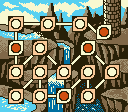
|
Rocky-Valley - Rocky-Valley features the most difficult puzzle stages of the game, but also requires the player to use Mario's moveset to the best of his abilities. There are many places which require strategic thinking and exact knowledge of the game's unusual physics. | 16 |
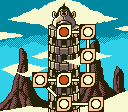
|
Tower - The Tower is the final stage of the game. In it, every single level is a boss fight with Donkey Kong or Donkey Kong Jr. Mario has to avoid many obstacles such as Poison Mushrooms and entire stages consisting of Sand Blocks. After Donkey Kong is defeated in stage 9-8, Mario has to fight him again in his giant form in stage 9-9. | 9 |
Gameplay
Level progression
The game starts out with four simple levels that Mario must scale in order to reach Pauline. These four levels are identical to the original Donkey Kong arcade game, except the lack of color. After reaching the top of the structure, Donkey Kong flees with Pauline into the city and beyond. The rest of the game's stages are divided between regular puzzle levels as well as more showdowns with Donkey Kong.
Each world has a varying amount of puzzle levels in which Mario needs to work against time to bring a key to a door to unlock it, thus advancing to the next level. The puzzles consist of building platforms and ladders and using them before they disappear, flipping switches, jumping on moving platforms, avoiding enemies and utilizing conveyor belts. Sometimes, Donkey Kong Jr. will get in Mario's way by flipping switches or throwing poisonous mushrooms at him to shrink him. All puzzles require the player to carefully time jumps and pay attention to the physics of the game - Donkey Kong thus is a cross between a platformer and a puzzle game.
As well as the puzzle levels, each world has at least two battles with Donkey Kong; one takes place part-way through the stage, and involves Mario reaching Pauline while avoiding the debris falling on him as Donkey Kong causes an impact. The second takes place at the end of each stage, and involves avoiding the barrels or other objects that Donkey Kong throws at Mario, picking them up and throwing them back at him. After beating a Donkey Kong boss level, there is a short cutscene of Mario chasing Donkey Kong while showing off how to do a special move in the game to the player. The player also gets one extra life for every 100 seconds of time left he or she had for the previous four levels, rounded up.
Each stage has a time limit in which it has to be beaten. It also keeps track of the high scores for each level. Whether the player made a new record is indicated on the Stage Clear screen after a Donkey Kong boss fight. The current high scores can also be viewed by pressing Start or Select.
In the final 'Tower' stage, each level consists of chasing Donkey Kong and Donkey Kong Jr. to the top of the tower, avoiding their attacks, eventually trapping Junior in a cage, and defeating a giant Donkey Kong in the final battle.
Mini-Games
There are also three items left behind by Pauline in each puzzle level - a parasol, a hat and a bag. Picking all three up before finishing the level will unlock a bonus mini-game in which the player can pick up extra lives. In The Wheel of Fortune mini-game, all the player has to do is to press to stop the wheel to gain either 1, 2 or, in later worlds, 3 lives. It is not possible to lose in The Wheel of Fortune.
In the Slot-Machine mini-game, the player has to press three times to stop each reel of the slot machine. The icons appearing on the reels are Mario, Donkey Kong, Pauline's hat, a hammer, and a Fire. Mario gains lives for getting one of the following combinations:
| Three Donkey Kongs | 5 Lives |
| Three Marios | 3 Lives |
| Two Marios | 2 Lives |
| One Mario | 1 Life |
| Three Hats | 2 Lives |
| Three Hammers | 1 Life |
| Three Fires | 1 Life |
| Donkey Kong, Mario, and Hat | Random |
This later appears in a mini game in Super Mario 64 DS
Basic controls
Mario is controlled with the . The physics in Donkey Kong are vastly different to those found in the Super Mario Bros. series. The player can jump with the
. Mario's jump allows him to jump on enemies, but it does not go up considerably high. When falling farther than his jump height, Mario does a somersault which gives him a little bit of momentum. If he lands on a small platform, it can cause him to roll over the side and fall off. If he falls further, he will be stunned and unable to move for several seconds upon hitting the ground, temporarily making him vulnerable. If he falls even farther, he lands on his head and dies upon impact with the ground.
Mario only has one hit point. While he is carrying any item, object or enemy, however, he cannot die. If he gets hit, he will instead drop the item and be invulnerable for a short amount of time. This can save Mario for most kinds of impending deaths - he will even survive spikes with it. If he falls too far, however, he will drop the item in mid-air.
Mario's abilities
| Picture | Move | Execution | Effect |
|---|---|---|---|

|
Crouching | Holding Down on the |
In the crouching position, Mario can avoid enemy projectiles more easily. He can also get through smaller passages while crouching and being on a conveyor belt. |

|
Handstand | Holding Down on the |
The handstand is an essential move in the game. While doing a handstand, Mario is protected from most items that drop onto him from above. Handstands also serve as a preparation for several other moves that Mario can only execute from the handstand position. While doing a handstand, Mario can still move to the right and to the left, but it is considerably slower than walking. |
| File:Mario High Jump From a Handstand.JPG | High Jump from a handstand | Pressing |
High Jumps allow Mario to reach platforms above him. If the High Jump is timed right after Mario goes into the handstand position, it allows Mario to jump a little bit higher than with a regular High Jump. |

|
Back Flip | Pressing |
Back Flips allow Mario to quickly reach higher platforms. They reach higher than High Jumps , but come at the disadvantage of having to be in movement to execute them, so they cannot be done on small platforms easily. |

|
Spinning on a rope | Pressing up on the |
Mario can hang onto ropes if he jumps at them. While hanging on the rope, the spin makes it possible for him to reach areas that are very high or very far away. The direction that Mario jumps to after the spin depends on the orientation of the rope. Sometimes, it is just upwards, sometimes it is sideways as well. |

|
Picking up objects | Pressing |
Similar to Super Mario Bros. 2, Mario can pick up objects like the key while standing on them. This also works for several enemies in the game. |

|
Throwing objects | Pressing |
Thrown objects can hit enemies and take them out. Some enemies are invulnerable to thrown objects. Mario also has to throw items like the Key upwards if he has to climb a ladder, as he cannot climb while holding any item. The key will disappear after a few seconds if left alone, while thrown enemies will struggle and stand up again. |
Enemies
Donkey Kong features the enemies from the original arcade game Donkey Kong and many individual enemies of its own that are only found in this game. It does not feature any enemies from the mainstream Mario games, except for Spark who appears in Super Mario Bros 2. Many enemies in the game have a different appearance, but the exact same behavior. The appearance usually depends on the current world.
| Enemy | Name | Debut | Abilities |
|---|---|---|---|
| Fire | World 0, 25m | Fires appear out of Oil Drums and chase Mario. If Mario touches one, he dies. In 100m, they are slightly larger. It can be defeated with the hammer. | |
| Oil | Big-City, stage 1-1 | Oil only consists of an aura of fire with the text "oil" written on it. It floats up and down in place without trying to attack Mario, but touching it is deadly. It can be defeated with the hammer. | |
| Bowbow | Big-City, stage 1-1 | Bowbows just lumber horizontally from one side of a platform to another. Mario, the curious plumber, dies if he gets in contact with a Bowbow from the front or back, but he can easily hop on its head, pick it up and hurl it away. If Mario approaches Bowbows with the hammer, they start to run away in panic. | |
| Rappy | Big-City, stage 1-2 | These enemies circle completely around midair platforms, including walking on their bottom side. In other stages, they also walk around the entire border of the level, even over spikes. They cannot hurt Mario, but they can push him off the platform if he is in their way. They can also be stood on, but not picked up. | |
| Dotty | Forest, stage 2-1 | ||
| Arumajiron | Desert, stage 5-7 | ||
| Purupuru | Iceberg, stage 7-3 | ||
| Spark | Big-City, stage 1-3 | Sparks move along ropes and electrocute Mario if he touches them. They may also appear and disappear from the rope in certain time intervals. Sparks can also not be harmed in any way. | |
| Trash Can | Big-City, stage 1-3 | These enemies look like ordinary Trash Cans at first glance, but grow feet and eyes once Mario gets too close. They then wander around aimlessly and can defeat Mario if they knock into him. Mario can safely stand on top of them, but they cannot be lifted like normal Trash Cans. | |
| Faiachū | Big-City, stage 1-5 | Faiachū circle around the area, and they also walk up walls and on ceilings. They burn Mario if he comes into contact with them. Faiachū also cannot be taken out by Trash Cans. In the Iceberg world, Faiachū melt Ice Blocks as soon as they walk over them, clearing the path for Mario to reach other areas of the level. | |
| Sniper | Forest, stage 2-1 | These enemies circle completely around midair platforms, including walk on their bottom side. In other stages, they also walk around the entire border of the level, even over spikes. They kill Mario if he touches them. | |
| Sukōpī | Desert, stage 5-11 | ||
| Chikuchiku | Rocky-Valley, stage 8-2 | ||
| Gyātoru | Tower, stage 9-3 | ||
| Dōryī | Forest, stage 2-3 | Dōryī shoot out seeds in regular intervals. The seeds fly horizontally across the screen and kill Mario if he touches them. However, Mario can touch the plants themselves and stand on them fine. | |
| Snapjaw | Forest, stage 2-4 | Snapjaws can climb ropes up and down. They kill Mario if he touches them, and they can only be defeated by dropping objects like fruit onto them. They are thrown by Donkey Kong Jr. | |
| Bukubuku | Forest, stage 2-5 | Bukubuku swim around horizontally, but charge at Mario if they get into eye contact with him. Touching a fish kills Mario. | |
| Kaibādo | Forest, stage 2-9 | These enemies fly out of their nests and cross the screen horizontally. At times, when they fly over Mario, they stop and attempt to drop an egg on him. Touching the eggs or the enemies themselves is deadly. | |
| Hōkusu | Rocky-Valley, stage 8-3 | ||
| Kuro | Tower, stage 9-4 | ||
| Sairesu | Forest, stage 2-10 | Sairesu are usually found sleeping on the floor. If they hear Mario approaching, they wake up and quickly charge at him. If Mario touches them, he gets killed. If he escapes them, Sairesu fall asleep again. Sairesu run faster than any other enemies in the game. | |
| Ussun | Ship, stage 3-1 | Ussun slowly walk horizontally, including across spikes. Mario can jump onto them to cross larger areas of spikes. Ussun do not hurt Mario in any way. | |
| Sir Shovalot | Ship, stage 3-2 | Sir Shovalots will hold their shield up and charge at Mario as soon as they see him. They do not hurt Mario themselves, but they push him away. They can push Mario off the platform he is currently standing on, but they can also push him against a wall, squishing him in the process. | |
| Kānyī | Ship, stage 3-2 | Kānyī walk around slowly, and sometimes stop and hide in their shell. Mario can stand on them fine, but will be defeated if he walks into them from the side. Kānyī also hurt Mario by reaching out to him with their extendable claws. | |
| Aqua Man | Ship, stage 3-3 | These enemies only walk around horizontally. If Mario runs into them, he will lose a life. He can stand on them, and they can also be picked up and thrown at other enemies. They can also be defeated with the hammer. Unlike Bowbow, they don't run away from Mario when he approaches them with the hammer. | |
| Miira | Desert, stage 5-2 | ||
| Penpen | Iceberg, stage 7-2 | ||
| Golem | Tower, stage 9-1 | ||
| Robo NO.1 | Tower, stage 9-6 | ||
| Kurasshā | Ship, stage 3-4 | If Mario approaches Kurasshā, they drop down and try to crush him. Mario can jump on them and use them as elevators. Kurasshā can also crush Mario by pushing him against the ceiling. | |
| Gessori | Ship, stage 3-7 | Gessori move around in the water horizontally. They kill Mario if he touches them. | |
| Dorakyū | Jungle, stage 4-5 | Dorakyū fly horizontally across the screen. When they hit Mario, they hang onto him and appear to suck a little bit of blood out of him. Mario's face turns white (in the colored Super Game Boy version) and he falls off the rope he is currently climbing. After falling to the ground, Mario gets up again. Mario can also get killed by Dorakyū if he falls too far after dropping from the rope. | |
| Skeleton | Desert, stage 5-2 | Skeleton foes move on the ground and throw bones on occasion. These bones, as well as the enemies themselves, are harmful for Mario, but they can be destroyed with a Hammer. | |
| Furafurawā | Desert, stage 5-2 | In the Desert, Furafurawā hide in the ground. If Mario approaches them, they pop out of the ground and move left and right slowly until he walks way. As soon as Mario is out of reach, Furafurawā hide again. Touching a Furafurawā kills Mario. They can be defeated with the Hammer, but will respawn from the ground instantly.
In Rocky-Valley, Furafurawā have a totally different behavior. They walk around slowly from the left to the right, and sometime shoot out four small seeds that behave like those of a Volcano Lotus. The seeds can be taken out with a Hammer. These Furafurawā do not respawn. | |
| Tsutanōmen | Desert, stage 5-12 | These enemies are thrown by Donkey Kong. When they hit the ground, they begin to walk around and kill Mario if he runs into one. Mario has to jump on them, pick them up and throw them at Donkey Kong to beat the ape. | |
| Rokkun | Rocky-Valley, stage 8-16 | ||
| Ottō | Iceberg, stage 7-2 | Ottō does not try to hurt Mario, but it jumps onto him and prevents him from walking or pulling switches for a certain amount of time. This makes it more difficult for the player to complete the level within the time limit. | |
| Tododesu | Iceberg, stage 7-2 | Tododesu patrol across the screen protecting the key. If a Tododesu gets into eye contact with Mario, it will charge at him with its fangs. Mario can stand on it, but he cannot pick it up like other enemies in the game. |
Allies
| Ally | Name | Debut | Abilities |
|---|---|---|---|
| Monchee | Jungle, stage 4-3 | Monchees have a long tail that Mario can use like a regular vertical rope. He can climb on it use it to cross gaps. Touching Monchees does not hurt him. | |
| Jumper | Jungle, stage 4-10 | When Mario is standing on a Jumper frog, it jumps up high in the air, allowing him to reach higher platforms while carrying the key. Jumpers can also be taken out if objects such as the key are thrown at them. |
Items
| Item | Name | Effect |
|---|---|---|
| Hammer | Hammers can defeat all enemies in the game. As soon as Mario grabs a hammer, he starts swinging the hammer back and forth repeatedly, and strikes anything in his path. While holding the hammer, Mario cannot jump, but he can throw the hammer upwards and then quickly climb up to a higher platform. If he catches the hammer up there in time, he can continue to use it. After a certain time, the hammer disappears and reappears in its original spot. | |
| Parasol, Hat, Bag | If Mario collects all three of these items within the same level, he gets to play a bonus mini-game after it is finished. | |
| 1 UP Heart | Gives Mario an extra life when collected. | |
| Key | Mario has to take the key to the locked door. It can be picked up and thrown. It can also take out several enemies if it is thrown. If Mario loses it, it will disappear after a few seconds and reappear in its original spot. | |
| Trash Can | Mario can stand on Trash Cans to reach higher areas, but he can also pick them up and throw them at enemies like Bowbows to defeat them, although other enemies like the Faiachū cannot be defeated by Trash Cans. Once it hits an enemy, it falls through the ground and cannot be reused. | |
| Road | Mario can place the road in any free point of the level for a certain amount of time. The road acts as an additional platform that can help him to get over gaps or to higher areas. | |
| Ladder | Mario can place this ladder in any free point of the level. It will disappear after a certain amount of time. | |
| Spring | Mario can place this spring in any free point of the level. It will disappear after a certain amount of time. | |
| Super Hammer | The Super Hammer has the same powers as the regular hammer, but can also destroy brick walls and grounds. They also respawn to their original positions when used up. |
Objects and obstacles
- Barrel - Donkey Kong throws barrels at Mario. He has to avoid them, and can also pick them up if they hit the ground. Barrels can be stopped falling by kicking against them in handstand position.
- Cannon - They fire bullets at Mario that kill him, and cannot be defeated.
- Conveyor belt - Conveyor belts move Mario and any other object such as the key into a certain direction. The direction of conveyor belts can be manipulated by Donkey Kong or via switches.
- Elevators - They allow Mario to get up or down. As falling too far kills Mario in the game, using them to get downwards is required on several occassions. Switches can change their direction.
- Jack - They are thrown by Donkey Kong in 75m and kill Mario if he gets hit by one.
- Ladder - Ladders are used to climb upwards. Several ladders in the game open and close at certain time intervals or when Donkey Kong hits the ground with his fist. While they are closed, Mario cannot go upwards on them.
- Switch - Switches have many different effects in the game. They can make Roads and Ladders appear disappear as well as open doors, and change the direction of conveyor belts and elevators.
- Locked Door - Mario progresses to the next level if he takes the key to it. In several levels, multiple locked doors appear, but only the one from which Pauline is seen screaming will actually open. In other levels, the locked door is hidden in the wall and the player has to remember its position.
- Oil Drum - As in the original arcade game, they spawn Fires.
- Rope - Ropes return from Donkey Kong Jr. Mario can climb up and down on them, and he climbs faster if he can hold onto a rope with each of his hands.
- Moving platform - They move around in fixed patterns at different speeds. Their direction can be changed with a switch.
- Sand Pile - As in the original arcade game, they kill Mario if he runs into one.
- Spring - They are stationary and give Mario a jump boost when he lands on one.
References to the other games
- Donkey Kong: The original Donkey Kong's plot is remade and extended in this game and even begins with all four stages from the arcade game and includes both the hammer and Pauline's dropped items.
- Donkey Kong Jr.: The character, as well as many enemies and gameplay elements from the game itself, are featured in the game.
- Super Mario Bros.: Donkey Kong uses Super Mushrooms to grow giant for the final battle. Also, the ending features a Warp Pipe and three ? Blocks (and Mario changing into Super Mario), leading to the idea that at least World 8 and World 9 are located in the Mushroom Kingdom. Additionally, the 1-Up Mushroom sound effect is included in the game. The ending of the game shows Mario coming out of a pipe, and Pauline standing in the Mushroom Kingdom under a bunch of blocks.
- Super Mario Bros.: The Lost Levels: Poison Mushrooms are featured in the game.
- Super Mario Bros. 2: The ability to pick up and throw items, as well as using keys to open doors, originated from this game.
References in later games
- Super Mario 64: Many of Mario's attacks return in this game.
- Donkey Kong Land: Big Ape City is, or at least is a reference to, Big-City.
- Mario vs. Donkey Kong: This game was originally planned to be a Game Boy Advance remake of the game, but ended up being a semi-sequel. As such, it uses all gameplay elements from the game, although it has a very different story.
- Mario vs. Donkey Kong 2: March of the Minis, Mario vs. Donkey Kong: Minis March Again!, Mario vs. Donkey Kong: Mini-Land Mayhem!, Mario vs. Donkey Kong: Tipping Stars: The characters can throw up their hammer to take it back at an upper level, as in Donkey Kong '94.
- Wario Land II: The theme for the Match the Panels and Number-Matching mini-games is borrowed from this game.
- Super Mario 64 DS: The slot machine minigame reappears.
Pre-release and unused content
Early footage of the game was featured in a promotional tape sent to Nintendo retailers in late 1993 and early 1994[1]. Differences include the sprites being closer to the original Donkey Kong and the level timer starting at 999 instead of 100. At some point, a "Giant Squirrel", pictured below, was a boss that Mario had to fight. A noticeable difference, besides that Donkey Kong and Donkey Kong Jr. are normally the only bosses fought, is that the stage has a very basic layout that does not fit with the more puzzle-like layout of the other stages.
- Dankey Kang 94 preview 1.PNG
- Dankey Kang 94 preview 2.PNG
- Dankey Kang 94 preview 3.PNG
- Dankey Kang 94 preview 4.PNG
Staff
- Main article: List of Donkey Kong (Game Boy) staff
Executive producer
Producer
Directors
- Masayuki Kameyama
- Takao Shimizu
Main programmers
- Yoshiaki Hoshino
- Masayuki Hirashima
Co-programmer
- Motoo Yasuma
Critical reception
The game has been received positively overall. Nintendojo named it one of the best Game Boy games ever made and rated it 9/10. They noted the game's innovate gameplay and its "seamless fusion" of the original arcade game with puzzle elements[2]. The German magazine Video Games noted that the game "belongs into every Game Boy collection" for its "love of detail and elaborate platform levels". They praised the game for providing new surprises in each new world, which keep the player at a high degree of motivation, and also for its battery storage. They gave the game 90%[3]. IGN.com said that the game took the "classic design to new heights with fresh action and puzzle elements that faithfully retained the Donkey Kong arcade game's look and feel". They said it was a "classic and amazingly fun" Game Boy game[4].
Gallery
Screenshots
All the screenshots below feature the game on the Super Game Boy and its exclusive border.
- MarioDKGB.PNG
Mario performing in front of an audience.
Official artwork
Mario Crouching
Mario holding a barrel
Mario throwing a key
Mario doing a handstand
- Mario High Jump From a Handstand.JPG
Mario doing a High Jump from a handstand
Mario back flipping
Mario spinning
Mario using the hammer
- Auline.png
Pauline
Donkey Kong Jr. pulling a switch
Miscellaneous
Super Game Boy promotion boxart
Trivia
- This is the first game, and so far the only one, to have Donkey Kong and son working together in order to get Pauline and defeat Mario.
- This is also the only game to have Donkey Kong Jr. as a "villain".
- In the Nintendo eShop description for this game, it says the release date was 6/1981 even though that is the release date of the original Donkey Kong arcade game.
- This game marks the first time Donkey Kong is wearing a tie.
- Donkey Kong in this game is the most recurring boss in a single game of the extended Mario series.
- This is the last major appearance of the original Donkey Kong; as of the next game, he is a separate character called Cranky Kong.
References
- ^ Service Center Update February 1994 (Donkey Kong-relevant part starts at 8:00)
- ^ Donkey Kong Review at Nintendojo
- ^ Donkey Kong review by Video Games, scan from kultpower.de
- ^ Mario vs. Donkey Kong review on IGN
| Game Boy games | |
|---|---|
| Super Mario franchise | Alleyway (1989) • Baseball (1989) • Super Mario Land (1989) • Golf (1989) • Dr. Mario (1990) • Super Mario Land 2: 6 Golden Coins (1992) • Donkey Kong (1994) • Mario's Picross (1995) • Picross 2 (1996) |
| Donkey Kong franchise | Donkey Kong (1994) • Donkey Kong Land (1995) • Donkey Kong Land 2 (1996) • Donkey Kong Land III (1997) |
| Yoshi franchise | Yoshi (1991) • Yoshi's Cookie (1992) • Tetris Attack (1996) |
| Wario franchise | Wario Land: Super Mario Land 3 (1994) • Wario Blast: Featuring Bomberman! (1994) • Wario Land II (1998) |
| Miscellaneous | Tetris (1989) • The Legend of Zelda: Link's Awakening (1993) • Game & Watch Gallery (1997) • Game & Watch Gallery 2 (1997) |
